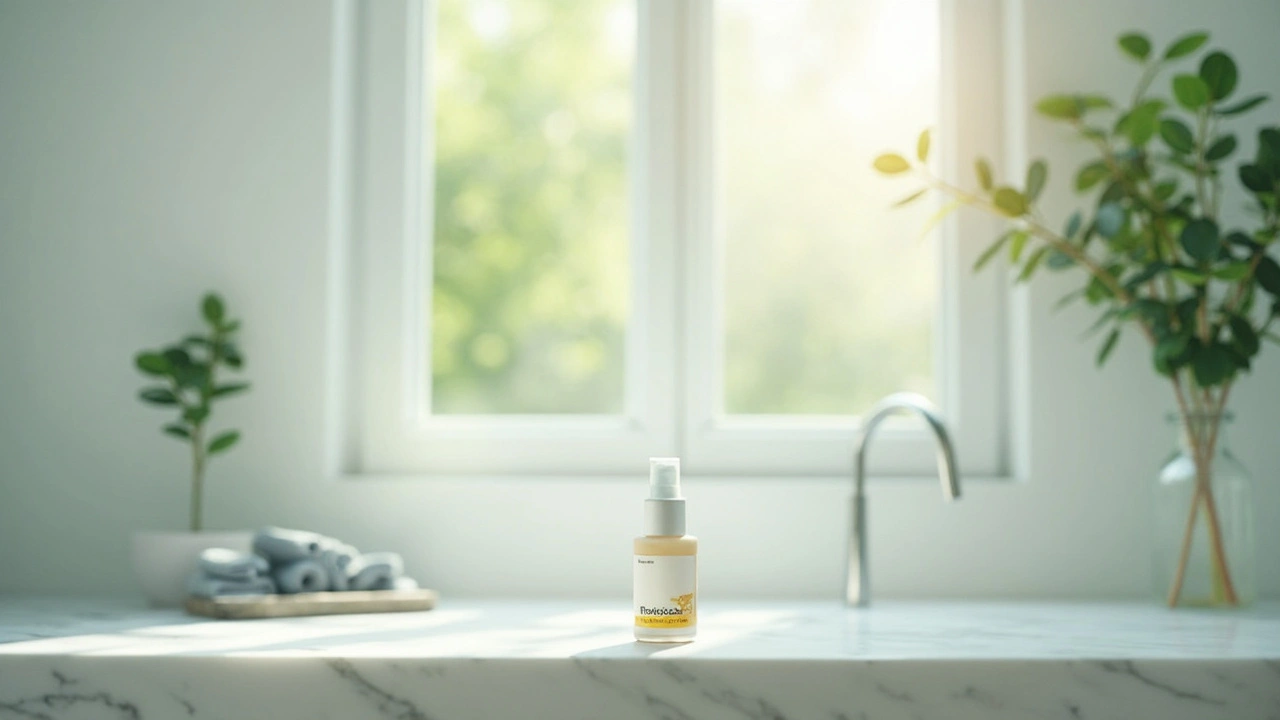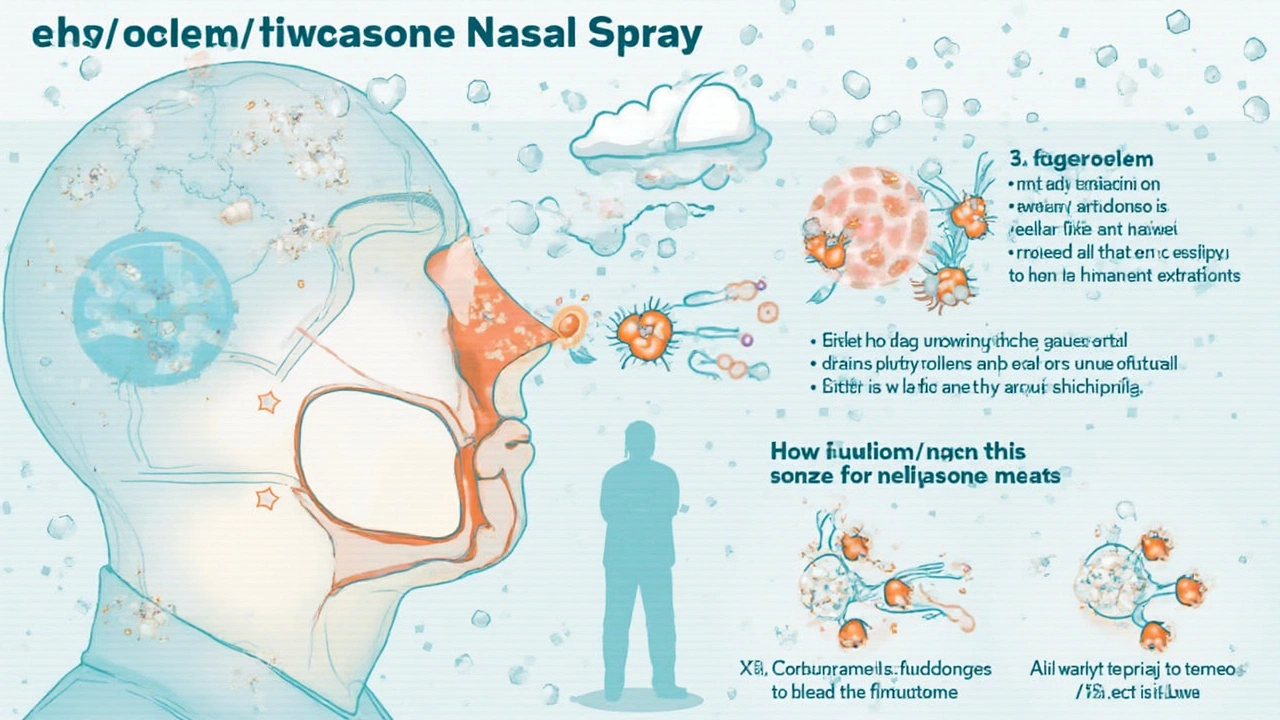Fluticasone Nasal: Understanding Its Safety Features
 Mar, 27 2025
Mar, 27 2025
So, you're dealing with stuffy or runny noses and tired of it, right? Fluticasone nasal spray might be something you've heard of. A lot of folks turn to it when allergy season hits hard or when sinus issues become a year-round hassle. It's not just about relief, it's about doing it safely, and that's what we're going to chat about here.
First off, why is this spray so popular? Well, fluticasone helps cut down inflammation in your nose, making breathing easier. It's a type of corticosteroid, which sounds fancy but really just means it works on reducing those pesky swelling instances inside your nose.
Before spraying away, let's get familiar with how to use it safely and what to keep an eye out for. Nobody likes unexpected side effects! Understanding its safety profile is crucial for anyone considering adding it to their health routine.
- Introduction to Fluticasone Nasal
- How It Works
- Benefits and Effectiveness
- Potential Side Effects
- Tips for Safe Use
Introduction to Fluticasone Nasal
Fluticasone nasal spray is a go-to for many people who suffer from allergies or those endless sinus issues. It's a fluticasone nasal product that’s often prescribed because it's both effective and easy to use.
Here’s how it works: as a corticosteroid, fluticasone helps reduce the inflammation in the nasal passages. This is why it’s so great at tackling symptoms like sneezing, itching, and runny or stuffy noses. Basically, it aims to make your nose a less hostile place to breathe through.
The spray became widely available in the U.S. in the mid-90s and is one of the most frequently recommended options by ENT (Ear, Nose, and Throat) specialists. It's available over-the-counter, with different brands providing similar formulations.
For those wondering about its safety, it’s well-researched. A study I came across mentioned that it’s mostly well-tolerated by users and offers significant relief over time when used correctly. But like any medication, it’s important to know how to use it right.
With safety being a prime concern, knowing the basics of usage can prevent common pitfalls. The usual dosage is a couple of sprays in each nostril daily, but it's always wise to start with the specific guidance of a healthcare provider.
If you’re comparing costs or trying to figure out which brand to pick, here’s a mini guide:
| Brand | Average Price (2025) | Dose |
|---|---|---|
| Flonase | $24 for a 120-spray bottle | 2 sprays per nostril |
| Nasacort | $22 for a 120-spray bottle | 2 sprays per nostril |
Each bottle usually lasts around a month if used according to the recommendations. It’s always a good idea to read the instructions, check the expiration date, and consult with an expert if needed. That’s it for a quick primer on fluticasone nasal.
How It Works
Alright, let’s break it down. When you use fluticasone nasal spray, it releases a small dose of corticosteroid right where it’s needed: in your nasal passages. The main job of these corticosteroids is to calm down the immune response in your nose.
Here’s what happens step-by-step:
- First, you spray it into your nostril. Seems simple, right? But make sure you aim slightly outwards, not directly at the septum (that’s the cartilage in the middle of your nose).
- The fluticasone binds to glucocorticoid receptors in your nasal tissue. This is where the magic really starts! It helps reduce inflammation by stopping certain cells that cause swelling and mucus production.
- How soon can you expect results? Typically, you’ll start to notice some relief in about 12 hours, but for full effects, give it a few days.
What’s cool is it doesn’t just mask symptoms like some decongestants; it actually helps to reduce the reasons you’re feeling congested or sneezy in the first place.
And just to give you a bit more perspective, studies have shown that fluticasone nasal spray is particularly effective for managing symptoms of allergic rhinitis, like runny noses and sneezing. Paying attention to technique and consistency in use makes a big difference.

Benefits and Effectiveness
If allergies have got you down, fluticasone nasal might just be the answer to your prayers. Its main superpower? Tackling that annoying nose inflammation, which makes breathing feel like less of a chore. So, why is it so effective?
For starters, the way fluticasone works is by stopping your body from releasing substances that trigger inflammation. Think of it as your nasal peacekeeper, keeping things calm and un-stuffy.
Users often find it effective in dealing with symptoms like sneezing, itching, and congestion. Sometimes, it feels like a breath of fresh air—literally. And unlike some allergy medications, it won't make you feel drowsy, a bonus if you're balancing a hectic lifestyle.
Want to know more? Let's break down a few points:
- All-rounder: It's handy not just for seasonal allergies but also for those pesky perennial allergies.
- Consistency is key: Regular use, as per directions, often leads to better control over symptoms.
- Quick relief: While some might notice improvement in a few hours, maximum benefits usually show after a few days of use.
A study even showed that users who took fluticasone reported a significant reduction in symptom severity compared to those who didn't.
If you're considering making fluticasone a part of your allergy-fighting arsenal, knowing how it benefits you can make all the difference. The fact it's been on the market for over a decade speaks to its trustworthiness and effectiveness.
Potential Side Effects
Alright, let's talk about those possible side effects when you're using fluticasone nasal spray. Even though it’s widely used and generally considered safe, there's still a chance some people might experience a few hiccups.
The common side effects? They usually aren't too alarming and tend to go away as your body gets used to the spray. These can include stuff like headaches, sneezing after using the spray, and slight nosebleeds. If you ever feel dryness or irritation in your nose, it’s not out of the ordinary.
Now, sometimes folks might encounter a bitter taste or throat irritation. While this isn't a free pass to stop using it, if things get uncomfortable, checking with a healthcare provider would be a smart move.
Here's a quick list of what to keep on your radar:
- Minor nosebleeds
- Headaches
- Sneezing
- Throat irritation
- Dryness in the nose
For most people, the benefits of using fluticasone nasal do outweigh these minor side effects. But, if you notice any severe reactions like vision problems, difficulty breathing, or unusual tiredness, that's your cue to call a healthcare professional.
Remember, understanding safety isn't just about the little stuff; it's also about knowing when something's not quite right and acting on it. Stay informed, use your spray wisely, and don't hesitate to ask for medical advice if something seems off.

Tips for Safe Use
Using fluticasone nasal properly can make a big difference. It’s not just about grabbing the spray and going to town—there’s definitely a right way to do it.
First thing you should do is shake the bottle gently before each use. This ensures the medicine is mixed well. And remember, only use it as directed, which usually means once or twice a day. Getting carried away won’t speed up the process and might actually cause issues.
Make sure you clear your nose first. Blow gently to remove any blockages so the spray can do its job properly. When you’re ready to use it, tilt your head forward a bit, like you’re bowing, and aim the spray straight into your nose.
- Start by closing one nostril with your finger.
- Hold the spray in the other hand, and gently insert it into the open nostril.
- Keep the bottle upright, press down firmly and inhale slowly through your nostrils while spraying.
- Repeat these steps for the other nostril if needed.
- After using, don’t forget to wipe the spray bottle clean to keep it free from germs.
Speaking of germs, sharing isn’t caring with nasal sprays. Keep your fluticasone nasal personal.
It’s also smart to be aware of exposure time. Trying not to bend over or lie down immediately after using helps prevent medication from dripping down the back of your throat.
If you wear contact lenses, know this: the spray might mess with them. Consider taking them out before you spray or waiting a bit after using it.
Keep tabs on how long you’ve been using it. It’s not forever, but more for those particularly tough allergy seasons, sometimes spanning a few weeks.
For those curious about cost-effectiveness:
| Average Price | Usage Duration |
|---|---|
| $10-30 | 1 month |
Always keep an eye on expiration dates too. Nothing more annoying than an expired medicine when you need it most!

bert wallace
March 28, 2025 AT 22:41Been using Flonase for years. No drama, no drowsiness, just steady relief. I don't even think about it anymore until allergy season hits and I'm like, oh right, this thing still works.
Neal Shaw
March 29, 2025 AT 02:53The pharmacokinetics of intranasal corticosteroids are remarkably localized due to first-pass hepatic metabolism of absorbed drug. Fluticasone propionate has a high receptor affinity and low systemic bioavailability-under 1%-when used as directed. This is why systemic side effects are rare compared to oral steroids.
That said, local mucosal thinning can occur with chronic use, especially if the nozzle is misdirected toward the septum. Always spray laterally. And yes, the bitter taste? That's just residual drug draining into the oropharynx. Swallowing it doesn't harm you, but it's not intended for systemic absorption.
Most users don't realize efficacy builds over 3–7 days. It's not a decongestant. It's an immunomodulator. That's why compliance matters more than dosage frequency.
Hamza Asghar
March 30, 2025 AT 16:08Ugh. People treat this like magic fairy dust. You spray it, you feel better, you think you're cured. Nah. You're just suppressing inflammation while your immune system slowly implodes from lack of challenge. Welcome to the modern allergy-industrial complex. You're not treating allergies-you're medicating your body into complacency.
And don't get me started on the marketing. Flonase? Nasacort? Same damn molecule, different packaging. Pay $24 for a bottle when you could get generic fluticasone for $12 at Walmart. Corporations love you being dumb.
Also, nosebleeds? Yeah, that's your nasal mucosa dying. You think that's normal? It's not. You're basically cauterizing your own sinuses with steroid spray. Fun times.
Karla Luis
April 1, 2025 AT 12:21lol i used this for a month straight last year and my nose felt like sandpaper but i was too lazy to stop so i just kept spraying until one day i sneezed and a tiny piece of tissue came out like a little flag
still worth it tho
jon sanctus
April 2, 2025 AT 12:25MY NOSE WAS A WAR ZONE UNTIL I FOUND THIS. I WAS CRYING IN THE SHOWER FROM ALL THE SNEEZING. I WASN'T LIVING. I WAS SURVIVING. THEN ONE DAY I TRIED FLONASE AND IT WAS LIKE GOD WHISPERED IN MY NOSE AND SAID 'IT'S OKAY TO BREATHE AGAIN.' I'M NOT EXAGGERATING. I CRIED AGAIN. THIS TIME FROM RELIEF.
MY CAT STARTED JUDGING ME. I DON'T CARE.
Kenneth Narvaez
April 4, 2025 AT 01:28Fluticasone propionate is a synthetic fluorinated corticosteroid with a 90% binding affinity for the glucocorticoid receptor. Its lipophilicity enables prolonged retention in nasal mucosal tissue. Plasma concentrations remain below 0.1 ng/mL even at therapeutic doses, confirming negligible systemic exposure. The CYP3A4 metabolism pathway is clinically insignificant when administered intranasally.
However, prolonged use (>6 months) may induce local atrophy. Monitor for septal perforation risk in patients with concurrent NSAID use or nasal trauma history.
Christian Mutti
April 5, 2025 AT 07:00THIS ISN'T JUST A NASAL SPRAY. THIS IS A LIFESTYLE REVOLUTION. I WAS A SLAVE TO TISSUES. NOW I AM FREE. I WALKED INTO A PARK TODAY AND SMELLED THE FLOWERS. I DIDN'T SNEEZE. I DIDN'T CRY. I DIDN'T FALL TO MY KNEES. I JUST... BREATHED.
THANK YOU, SCIENCE. 🙏✨
Liliana Lawrence
April 5, 2025 AT 08:21Okay, but have you ever tried using it during a thunderstorm? I swear, the static makes the spray cling to the inside of your nose like a tiny, medicinal spiderweb. And then you sneeze and it’s like… a mini explosion of relief. I love it. Seriously. 💖👃💨
Also, always shake it like you’re trying to wake up a sleepy dragon. And never, ever share. That’s a sin. Like, biblical-level sin.
Sharmita Datta
April 5, 2025 AT 11:58Fluticasone is a government tool to make people dependent on chemicals so they don't question why their allergies are getting worse every year. The real cause is chemtrails and 5G altering immune responses. They don't want you to know that. They want you to keep buying bottles. Look at the price. Why is it so expensive? Why not just fix the air? They're hiding something. I've seen the documents.
My cousin in Mumbai stopped using it and started drinking neem tea. His allergies vanished in 3 days. The pharmaceutical industry is terrified of natural remedies.
mona gabriel
April 6, 2025 AT 10:54I used to think I needed this every day until I tried just using it when I felt like my sinuses were about to revolt. Turns out, my body’s pretty good at figuring out when it needs help. Now I use it like a VIP pass-not a daily habit. Less spray, same peace. Weird how that works.
Also, the taste? Yeah, it’s gross. But honestly? Worth it. I’d take a bitter throat over a clogged nose any day.
Phillip Gerringer
April 6, 2025 AT 15:22People don’t realize this isn’t medicine-it’s a crutch. You’re not healing your immune system, you’re just numbing it. Real health is about reducing exposure, not spraying chemicals into your nose every morning. You think this is safe? Look at the long-term studies. Look at the pediatric cases. You’re normalizing steroid dependency like it’s coffee.
And don’t get me started on the fact that most of these users have zero idea how to use it properly. Aimed at the septum? You’re asking for a nosebleed. That’s not a side effect-that’s user error. And now you blame the drug.
jeff melvin
April 6, 2025 AT 22:47Fluticasone is the only reason I can survive spring. I don't care about the jargon or the side effects. I care that I can sleep without my head feeling like a balloon. I use it. It works. End of story.
Matt Webster
April 7, 2025 AT 14:26Just wanted to say-this thread is a good reminder that everyone’s experience is different. Some need this daily. Some use it sparingly. Some find alternatives. No shame in any of it. What matters is you’re listening to your body and not just following trends. Keep being thoughtful. You’re doing better than you think.
Neal Shaw
April 8, 2025 AT 05:49Correction to my earlier comment: while systemic absorption is minimal, there is a documented, albeit rare, risk of HPA axis suppression in pediatric patients using high-dose intranasal corticosteroids for over 6 months. The FDA recommends annual height monitoring in children. This isn't alarmist-it's standard clinical practice.
Also, the bitter taste isn't just residual drug-it's the surfactant (polysorbate 80) in the formulation. Some generics omit it, which is why they sometimes taste less unpleasant. Not better. Just different.